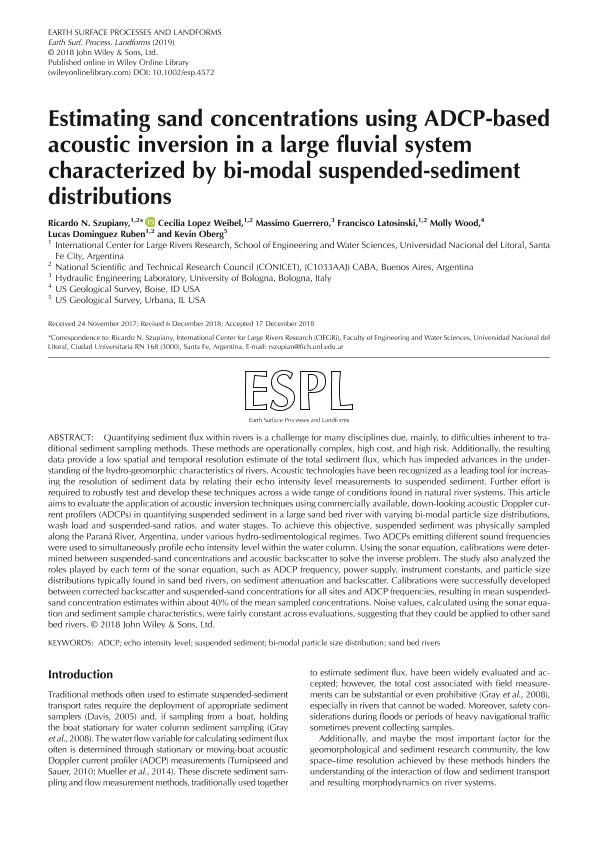Mostrar el registro sencillo del ítem
dc.contributor.author
Szupiany, Ricardo Nicolas

dc.contributor.author
López Weibel, Cecilia

dc.contributor.author
Guerrero, M.
dc.contributor.author
Latosinski, Francisco Guillermo

dc.contributor.author
Wood, M.
dc.contributor.author
Dominguez Ruben, Lucas Gerardo

dc.contributor.author
Oberg, K.
dc.date.available
2022-02-09T18:06:55Z
dc.date.issued
2018-12
dc.identifier.citation
Szupiany, Ricardo Nicolas; López Weibel, Cecilia; Guerrero, M.; Latosinski, Francisco Guillermo; Wood, M.; et al.; Estimating sand concentrations using ADCP-based acoustic inversion in a large fluvial system characterized by bi-modal suspended-sediment distributions; John Wiley & Sons Ltd; Earth Surface Processes And Landforms; 44; 12-2018; 1295-1308
dc.identifier.issn
0197-9337
dc.identifier.uri
http://hdl.handle.net/11336/151694
dc.description.abstract
Quantifying sediment flux within rivers is a challenge for many disciplines due, mainly, to difficulties inherent to traditional sediment sampling methods. These methods are operationally complex, high cost, and high risk. Additionally, the resulting data provide a low spatial and temporal resolution estimate of the total sediment flux, which has impeded advances in the understanding of the hydro‐geomorphic characteristics of rivers. Acoustic technologies have been recognized as a leading tool for increasing the resolution of sediment data by relating their echo intensity level measurements to suspended sediment. Further effort is required to robustly test and develop these techniques across a wide range of conditions found in natural river systems. This paper aims to evaluate the application of acoustic inversion techniques using commercially available, down‐looking acoustic Doppler current profilers (ADCPs) in quantifying suspended sediment in a large sand bed river with varying bi‐modal particle size distributions, wash load and suspended‐sand ratios, and water stages. To achieve this objective, suspended sediment was physically sampled along the Paraná River, Argentina, under various hydro‐sedimentological regimes. Two ADCPs emitting different sound frequencies were used to simultaneously profile echo intensity level within the water column. Using the sonar equation, calibrations were determined between suspended‐sand concentrations and acoustic backscatter to solve the inverse problem. The study also analyzed the roles played by each term of the sonar equation, such as ADCP frequency, power supply, instrument constants, and particle size distributions typically found in sand bed rivers, on sediment attenuation and backscatter. Calibrations were successfully developed between corrected backscatter and suspended‐sand concentrations for all sites and ADCP frequencies, resulting in mean suspended‐sand concentration estimates within about 40% of the mean sampled concentrations. Noise values, calculated using the sonar equation and sediment sample characteristics, were fairly constant across evaluations, suggesting that they could be applied to other sand bed rivers.
dc.format
application/pdf
dc.language.iso
eng
dc.publisher
John Wiley & Sons Ltd

dc.rights
info:eu-repo/semantics/openAccess
dc.rights.uri
https://creativecommons.org/licenses/by-nc-sa/2.5/ar/
dc.subject
ADCP
dc.subject
BI-MODAL PARTICLE SIZE DISTRIBUTION
dc.subject
ECHO INTENSITY LEVEL
dc.subject
SAND BED RIVERS
dc.subject
SUSPENDED SEDIMENT
dc.subject.classification
Otras Ingeniería del Medio Ambiente

dc.subject.classification
Ingeniería del Medio Ambiente

dc.subject.classification
INGENIERÍAS Y TECNOLOGÍAS

dc.title
Estimating sand concentrations using ADCP-based acoustic inversion in a large fluvial system characterized by bi-modal suspended-sediment distributions
dc.type
info:eu-repo/semantics/article
dc.type
info:ar-repo/semantics/artículo
dc.type
info:eu-repo/semantics/publishedVersion
dc.date.updated
2020-11-27T18:48:44Z
dc.journal.volume
44
dc.journal.pagination
1295-1308
dc.journal.pais
Reino Unido

dc.journal.ciudad
Londres
dc.description.fil
Fil: Szupiany, Ricardo Nicolas. Universidad Nacional del Litoral. Facultad de Ingeniería y Ciencias Hídricas. Departamento de Hidráulica; Argentina. Consejo Nacional de Investigaciones Científicas y Técnicas. Centro Científico Tecnológico Conicet - Santa Fe; Argentina
dc.description.fil
Fil: López Weibel, Cecilia. Universidad Nacional del Litoral. Facultad de Ingeniería y Ciencias Hídricas. Departamento de Hidráulica; Argentina. Consejo Nacional de Investigaciones Científicas y Técnicas. Centro Científico Tecnológico Conicet - Santa Fe; Argentina
dc.description.fil
Fil: Guerrero, M.. Universidad de Bologna; Italia
dc.description.fil
Fil: Latosinski, Francisco Guillermo. Universidad Nacional del Litoral. Facultad de Ingeniería y Ciencias Hídricas. Departamento de Hidráulica; Argentina. Consejo Nacional de Investigaciones Científicas y Técnicas. Centro Científico Tecnológico Conicet - Santa Fe; Argentina
dc.description.fil
Fil: Wood, M.. United States Geological Survey; Estados Unidos
dc.description.fil
Fil: Dominguez Ruben, Lucas Gerardo. Consejo Nacional de Investigaciones Científicas y Técnicas. Centro Científico Tecnológico Conicet - Santa Fe; Argentina. Universidad Nacional del Litoral. Facultad de Ingeniería y Ciencias Hídricas. Departamento de Hidráulica; Argentina
dc.description.fil
Fil: Oberg, K.. United States Geological Survey; Estados Unidos
dc.journal.title
Earth Surface Processes And Landforms

dc.relation.alternativeid
info:eu-repo/semantics/altIdentifier/doi/http://dx.doi.org/10.1002/esp.4572
dc.relation.alternativeid
info:eu-repo/semantics/altIdentifier/url/https://onlinelibrary.wiley.com/doi/abs/10.1002/esp.4572
Archivos asociados
